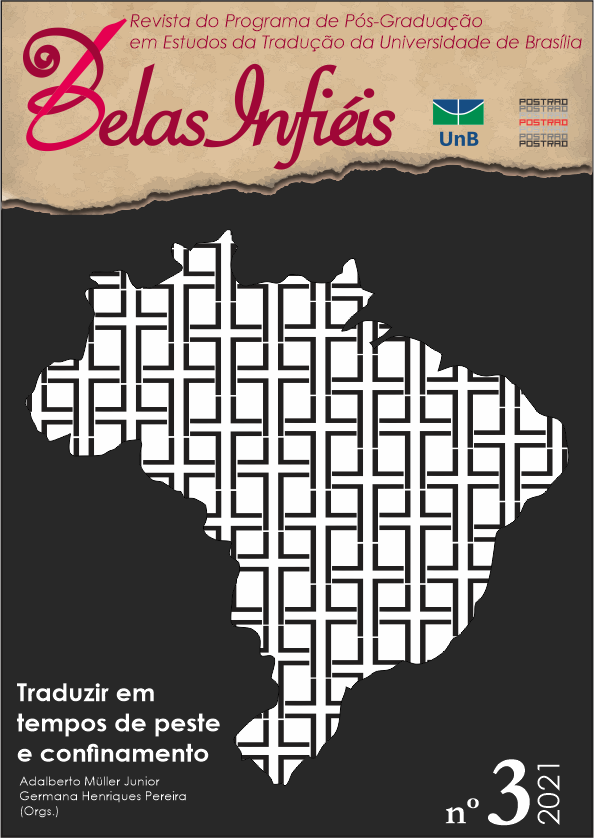The translation of COVID-19 into Spanish sign language
DOI:
https://doi.org/10.26512/belasinfieis.v10.n3.2021.33966Keywords:
COVID-19. Coronavirus. Translation. Techniques. Spanish Sign Language.Abstract
The year 2020 will be remembered for being the year when a new coronavirus made the world wobble. Health systems in all countries are faced with COVID-19, a disease for which we do not have sufficient resources. The successful implementation of preventive measures by society is essential to prevent its spread. However, the information provided by governments is not accessible to all citizens and deaf people find it difficult not to be in sign language, which has serious consequences for their health and that of everyone else. The present paper analyses the translation techniques applied to translate terms about COVID-19 into Spanish sign language (LSE). Through the compilation of a parallel video graphic corpus in LSE and Spanish with subtitles, and taking as a reference the proposal of translation techniques by Hurtado (2001), we have identified the procedures used by a deaf translator to achieve these equivalences. The results reveal that borrowing, either from oral language (through fingerspelling) or from other sign languages (with the widespread sign for coronavirus), is the main resource to cope with the neologisms that have arisen. Furthermore, the use of different techniques for the same word has been found, even when there is an equivalent in LSE dictionaries. Among all of them, generalization stands out as a procedure to make texts more understandable in the target culture, which indicates the importance of cultural and social knowledge in the translator. All of this demonstrates the functionality of translation techniques and the adaptation that is made of them taking into account the (con)text, as well as the dynamic nature of the equivalents. This exploratory research allows us to go deeper into these translation procedures in order to make this information more accessible to the deaf community and to fight together against COVID-19.
Downloads
References
AMORIM, Gildete, Alex Sandro Ramos, Gláucio de Castro Junior, Luciana de Souza y Helena Castro. “Coronavirus, Deafness and the Use of Different Signs of the Area in Health during a Period of Pandemic Time: Is That the Best Option to Do?”. Creative Education 11, (2020): 573-80. https://doi.org/10.4236/ce.2020.114042
BÉLANGER, Danielle-Claude. “The specificities of Quebéc Sign Language Interpreting. First Part: Analysis using the Effort Model of Interpreting”. The Sign Language Interpreting Studies Reader. Eds. Cynthia B. Roy y Jemina Napier. Amsterdam/Philadelphia: John Benjamins. B. V., 1995/2015. 242-51. Impreso.
CASTRO, Helena Carla, Alex Sandro Lins Ramos, Gildete Amorim, y Norman Ratcliffe. “COVID-19: Don’t Forget Deaf People”. Nature 579, (2020): 343. https://doi.org/10.1038/d41586-020-00782-2
COSTELLO, Brendan, Javier Fernández, Saúl Villameriel y Marta Mosella. “Una lengua sin nativos: consecuencias para la normalización”. Estudios sobre la lengua de signos española. III Congreso Nacional de la lengua de signos española: hacia la normalización de un derecho lingüístico y cultural. Madrid: UNED, 2012. 371-88. Impreso.
CNSE. “Los vídeos informativos de la Confederación Estatal de Personas Sordas sobre el coronavirus superan las 600.000 reproducciones”. Discapnet. 9 jul 2020. Actualidad y eventos: Noticias sobre Discapacidad. Web. 7 ago. 2020. < https://www.discapnet.es/actualidad/2020/07/los-videos-informativos-de-la-confederacion-estatal-de-personas-sordas-sobre-el>
DE LOS SANTOS, Esther y Pilar Lara. Técnicas de interpretación de lengua de signos. 2ª ed. Madrid: Fundación CNSE, 2004. Impreso.
EUD [EUROPEAN UNION OF THE DEAF]. Report on EUD consultative virtual regional meetings with the National Associations of the Deaf in Europe in the context of COVID-19 pandemic. Julio 2020. Web. 27 ago. 2020. < https://www.eud.eu/news/report-eud-consultative-virtual-regional-meetings-national-associations-deaf-europe-context-covid-19-pandemic/>
FLICK, Uwe. El diseño de investigación cualitativa. Madrid: Ediciones Morata, 2015. Impreso.
FUNDACIÓN CNSE. Guía de accesibilidad para personas sordas en las industrias culturales. 2013. Web. 7 ago. 2020. < http://www.fundacioncnse.org/pdf/Guia_accesibilidad_industrias_culturales_personas_sordas_def.pdf>
Autor1 (2020)
Autor1 et al. (2020)
GRUPO PACTE. “La competencia traductora y su adquisición”. Quaderns. Revista de Traducció 6, (2001): 39-45. < https://ddd.uab.cat/pub/quaderns/11385790n6/11385790n6p39.pdf>
HALE, Sandra. La interpretación comunitaria: la interpretación en los sectores jurídico, sanitario y social. Coord. Carmen Valero. Granada: Comares, 2010. Impreso.
HERNÁNDEZ, Roberto, Carlos Fernández, y Pilar Baptista. Metodología de la investigación. 6ª ed. México: McGraw-Hill, 2014. Impreso.
HURTADO, Amparo. Traducción y Traductología. Introducción a la Traductología. Madrid: Cátedra, 2001. Impreso.
LAZCANO-PONCE, Eduardo y Celia Alpuche-Aranda. “Alfabetización en salud pública ante la emergencia de la pandemia por Covid-19”. Salud Pública de México 62,3, (2020): 331-40. https://doi.org/10.21149/11408
MAJOR, George, Jemina Napier, Lindsay Ferrara y Trevor Johnston. “Exploring lexical gaps in Australian Sign Language for the purposes of health communication”. Communication & Medicine 9.1 (2012): 37-47. https://doi.org/10.1558/cam.v9i1.37
MARGELLOS-ANAST, Helen, et al. “Developing a standardized comprehensive health survey for use with deaf adults”. American Annals of the Deaf 150,4, (2005): 388-96. https://doi.org/10.1353/aad.2005.0039
MARTÃN, Jesús y María José Nieto. “Lengua de signos española: un idioma clave en el acceso de las personas sordas a los bienes culturales”. Estudios sobre la lengua de signos española. III Congreso Nacional de la lengua de signos española: hacia la normalización de un derecho lingüístico y cultural. Madrid: UNED, 2012. 155-61. Impreso
MERRIAM, Sharan B. Qualitative research: a guide to design and implementation. San Francisco: Jossey-Bass, 2009. Impreso.
NIDA, Eugene A. Toward a science of translating: with special reference to principles and procedures involved in Bible translating. Leiden: E.J. Brill, 1964. Impreso.
OMS. “Coronavirus disease (COVID-19). Weekly Epidemiological Update”. Organización Mundial de la Salud. 31 ago. 2020. Web. 31. ago. 2020. < https://www.who.int/docs/default-source/coronaviruse/situation-reports/20200831-weekly-epi-update-3.pdf?sfvrsn=d7032a2a_4>
OMS. Disability considerations during the COVID-19 outbreak. Organización Mundial de la Salud. 2020. Web. 30 ago. 2020. <https://apps.who.int/iris/handle/10665/332015>.
OROZCO, Mariana. “Propuesta de un catálogo de técnicas de traducción: la toma de decisiones informada ante la elección de equivalentes”. Hermeneus: Revista de Traducción e Interpretación 16, (2014): 233”“64. < https://recyt.fecyt.es/index.php/HS/article/view/33275>
PÖCHHACKER, Franz. Introducing interpreting studies. London: Routledge, 2004. Impreso.
QUADROS, Ronice Müller de. O tradutor e intérprete de língua brasileira de sinais e língua portuguesa, Brasília: MEC ”“ Secretaria de Educação Especial (SEESP), 2004. Web. 5 ago. 2020. <http://portal.mec.gov.br/seesp/arquivos/pdf/tradutorlibras.pdf>
QUADROS, Ronice Müller de. y Rimar R. Segala. “Tradução intermodal, intersemiótica e interlinguística de textos escritos em Português para a Libras oral”. Cadernos de Tradução 35,2, (2015): 354-86. https://doi.org/10.5007/2175-7968.2015v35nesp2p354.
QUADROS, Ronice Müller de. y Saulo Xavier Souza. “Aspectos da tradução/encenação na língua de sinais brasileira para um ambiente virtual de ensino: práticas tradutórias do curso de letras libras”. Estudos Surdos III. Org. Ronice Müller de Quadros. Petropolis: Editora Arara Azul, 2008. 168-207. Web. 6 ago. 2020. <http://editora-arara-azul.com.br/site/ebook/detalhes/16>
RAE. “Las palabras más buscadas en el diccionario durante la cuarentena”. Real Academia Española. 7 abr. 2020. Web. 13 ago. 2020. <https://www.rae.es/noticias/las-palabras-mas-buscadas-en-el-diccionario-durante-la-cuarentena>
SÁNCHEZ, Elena. Teoría de la traducción: convergencias y divergencias. Vigo: Servicio de Publicacións da Universidade de Vigo, 2002. Impreso.
SEGALA, Rimar R. “Tradução intermodal e intersemiótica/interlinguística: portugués escrito para a língua de sinais”. Tesis de Maestría. Universidade Federal de Santa Catarina, 2010. Web. 6 ago. 2020. <https://repositorio.ufsc.br/xmlui/bitstream/handle/123456789/94582/283099.pdf?sequence=1&isAllowed=y>
WFD. “Statement on Equality & Non-Discrimination during the Global Covid-19 Pandemic”. World Federation of the Deaf. 11 may. 2020. Web. 28 ago. 2020. <https://wfdeaf.org/wp-content/uploads/2020/05/Statement-on-Non-Discrinination_Covid-19-situation_April-2020.docx.pdf>
Downloads
Published
How to Cite
Issue
Section
License
Copyright (c) 2021 CC BY

This work is licensed under a Creative Commons Attribution 4.0 International License.
Given the public access to this journal, the texts are free to use but requires the recognition of the original authorship and initial publication in this journal to be properly stated.
 The journal allows the use of works published for non-commercial purposes, including the right to submit the work to publicly accessible databases. Published contributions are the sole and exclusive responsibility of the author(s).Â



















